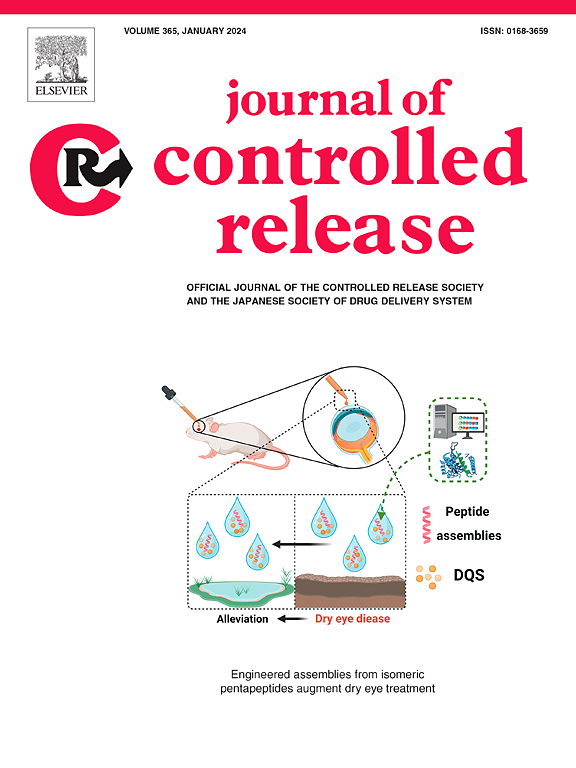Integrity of polymeric micelles regulates bioavailability of cyclosporine A: A FRET-based analysis during oral delivery
IF 10.5
1区 医学
Q1 CHEMISTRY, MULTIDISCIPLINARY
引用次数: 0
Abstract
This study comprehensively investigated the effect of structural integrity on the oral delivery efficacy of mPEG-b-PCL polymeric micelles (PMs) using fluorescence resonance energy transfer (FRET) technology. During mucus penetration, the integrity loss of PMs resulted from the “hydration effect” of mucins and the “solubilization effect” of bile salts. Increasing surface PEG density or decreasing particle size <50 nm resisted the “hydration effect”, while shortening PCL chain or increasing aggregation number alleviated the “solubilization effect”. Fluorescence colocalization studies demonstrated that low surface PEG density and small particle size enhanced the cellular uptake of PMs, but high surface PEG density preserved the intracellular integrity of PMs. Approximately 30 %–60 % of endocytosed PMs were expelled within 4 h, correlating with their cellular uptake efficiency. Transcellular transport results indicated that 5 %–25 % of PMs underwent transcytosis within 4 h, 0.5 %–10 % of initial PMs remained intact. In situ intestine perfusion data confirmed the consistency between the in vitro findings and the actual performance of PMs in vivo. Two types of PMs were selected to encapsulate cyclosporine A (CyA) based on their enhanced integrity and transcytosis efficiency. The PM with a short amphiphilic block and loose structure exhibited comparable in vitro release and in vivo performance to Neoral®, with a Cmax of 1356.28 ± 170.01 ng/mL, a Tmax of 2 h, and an AUC0-t of 16,408.92 ± 1166.78 ng/mL*h. However, the PM with a long amphiphilic block and ordered core PCL arrangement exhibited sustained release of CyA both in vitro and in vivo, decreasing CyA accumulation in major organs and improving the oral bioavailability of CyA, with a Cmax of 757.07 ± 66.19 ng/mL, a Tmax of 9.33 ± 2.31 h, and an AUC0-t of 21,938.44 ± 2183.59 ng/mL*h.


聚合物胶束的完整性调节环孢素A的生物利用度:口服给药过程中基于fret的分析
本研究采用荧光共振能量转移(FRET)技术全面研究了结构完整性对mPEG-b-PCL聚合物胶束(pm)口服递送效果的影响。在黏液渗透过程中,粘蛋白的“水化作用”和胆盐的“增溶作用”导致pmms的完整性丧失。增加表面PEG密度或减小粒径<;50 nm可抑制“水化效应”,缩短PCL链或增加聚集数可缓解“增溶效应”。荧光共定位研究表明,低表面PEG密度和小粒径增强了pm的细胞摄取,但高表面PEG密度保留了pm的细胞内完整性。大约30% % - 60% %的内吞pm在4 小时内被排出,这与它们的细胞摄取效率相关。跨细胞转运结果表明,5 % -25 %的pmms在4 小时内发生了胞吞作用,0.5 % -10 %的初始pmms保持完整。原位肠灌注数据证实了体外研究结果与pmms体内实际性能之间的一致性。基于其增强的完整性和胞吞效率,选择了两种类型的pm来包封环孢素A (CyA)。该PM具有较短的两亲性块和松散的结构,其体外释放和体内性能与Neoral®相当,Cmax为1356.28 ± 170.01 ng/mL, Tmax为2 h, AUC0-t为16,408.92 ± 1166.78 ng/mL*h。然而,下午一块长两亲性和命令核心PCL安排表现出持续释放自保”体外和体内,减少自保”积累的主要器官,提高自保”的口服生物利用度,Cmax 757.07 ±66.19 ng / mL,达峰时间为9.33 ±2.31 h和21938 .44点AUC0-t ±2183.59 ng / mL * h。
本文章由计算机程序翻译,如有差异,请以英文原文为准。
求助全文
约1分钟内获得全文
求助全文
来源期刊

Journal of Controlled Release
医学-化学综合
CiteScore
18.50
自引率
5.60%
发文量
700
审稿时长
39 days
期刊介绍:
The Journal of Controlled Release (JCR) proudly serves as the Official Journal of the Controlled Release Society and the Japan Society of Drug Delivery System.
Dedicated to the broad field of delivery science and technology, JCR publishes high-quality research articles covering drug delivery systems and all facets of formulations. This includes the physicochemical and biological properties of drugs, design and characterization of dosage forms, release mechanisms, in vivo testing, and formulation research and development across pharmaceutical, diagnostic, agricultural, environmental, cosmetic, and food industries.
Priority is given to manuscripts that contribute to the fundamental understanding of principles or demonstrate the advantages of novel technologies in terms of safety and efficacy over current clinical standards. JCR strives to be a leading platform for advancements in delivery science and technology.
 求助内容:
求助内容: 应助结果提醒方式:
应助结果提醒方式:


